After experiencing October’s two highest consecutive temperatures on record (37'C & 39'C) on Friday and Saturday, Sunday saw Sydney cool down to a humid 20'C with a brisk wind coming in from the sea.
As part of Good Food Month I journeyed down to Woolloomooloo’s Cowper Wharf, with Nicki and Slinky Minx, for Manta’s biannual Oyster Forum.
MANTA
The Wharf, 6 Cowper Wharf Road
Woolloomooloo, Sydney, Australia
www.mantarestaurant.com.au
Chef: Daniel Hughes
Perched on the wharf beside bobbing yachts, the naturally lit restaurant was set up in long tables of twelve. By some bizarre twist of fate my neighbour turned out to be the good friend of a good friend so it was a great surprise and lovely company throughout the meal.
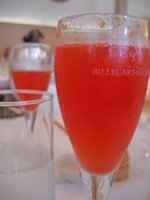 The $85 lunch (bargain!!!) started with a welcome aperitif of prosecco and blood orange juice. I was very excited to discover that Manta has generously provided five wines for taste testing with the oysters. I hadn’t read that wine was included in the lunch and so I was prepared to buy a glass or two. Bonus!
The $85 lunch (bargain!!!) started with a welcome aperitif of prosecco and blood orange juice. I was very excited to discover that Manta has generously provided five wines for taste testing with the oysters. I hadn’t read that wine was included in the lunch and so I was prepared to buy a glass or two. Bonus!The Forum was well coordinated with a moderator, Simon Marnie, who is a radio and TV presenter and also happens to be an oyster judge for the Royal Agricultural Society Easter Show.
Other panellists enlisted to discuss the growing, selling, preparing and eating of oysters included:
Tim Connell – Manta’s owner who was once a shucker and seafood provedore. He was also the founder of the Tasmanian Pacific Oyster Company.
Chris Boynton – oyster farmer, specialising in Sydney Rock oysters and also the rare Angasi variety.
Gary Rodley – proprietor of Tathra Oysters in Nelson's Lagoon (regarded as the best oyster growing wilderness lagoon in NSW). His oysters and farming techniques have won over 125 awards since 1992.
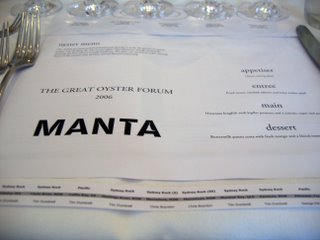 Pacific oysters are not native to Australian waters and were introduced from Asia. They can grow anywhere and as one of the oyster growers at the Forum said, “I could cultivate them in a bathtub”. They are very fast to mature (about 12 months) whereas Sydney Rock Oysters take at least 2½ years. Pacific oysters are prized for their size and white flesh.
Pacific oysters are not native to Australian waters and were introduced from Asia. They can grow anywhere and as one of the oyster growers at the Forum said, “I could cultivate them in a bathtub”. They are very fast to mature (about 12 months) whereas Sydney Rock Oysters take at least 2½ years. Pacific oysters are prized for their size and white flesh.Sydney Rock oysters are a native oyster which has been farmed since the 1870s but people have been enjoying them since the first person set foot on this continent. Carbon dating puts Aboriginal shell deposits at 6000 BCE!
Sydney Rock oysters are smaller than Pacific oysters and have a more intense flavour. They have a very creamy texture and buttery, yellow coloured flesh. They certainly don’t look as pretty as a Pacific oyster, but I think their flavour is superior.
Sydney Rock oysters are at their prime during spawning season when they are enlarged and swollen. As they said at the Oyster Forum “a lusty oyster is a good oyster”.
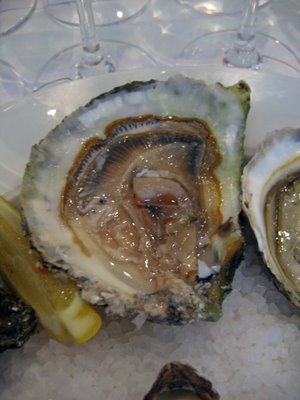 Angasi oysters Ostrea angasi (above) are oysters native to southern QLD, WA and all southern States in Australia. They were an important part of the Aboriginals’ diet before Europeans arrived but were almost wiped out due to settler’s desire for the large shells to make mortar.
Angasi oysters Ostrea angasi (above) are oysters native to southern QLD, WA and all southern States in Australia. They were an important part of the Aboriginals’ diet before Europeans arrived but were almost wiped out due to settler’s desire for the large shells to make mortar.Angasi are large, fleshy oysters with brownish meat that retain quite a strong flavour. They were mostly farmed in Tasmania until farmers switched to the ever popular Pacific oysters instead. Now the Angasi is making a comeback since they fetch significantly higher prices than the other oysters and are prized by those in the know. They have been nicknamed “the venison of the oyster world” by industry connoisseurs.
At the Oyster Forum I also learnt about shucking an oyster. Apparently front shucking (cracking into the flat, front of the shell) is faster but shatters the shell and puts grit into oyster. This is how most seafood stores and fish markets open oysters because it is three times faster than back shucking. Usually oysters that have been front shucked have also been washed which means you lose the lovely brine inside. Che terribile!
Back shucking enters from the hinge and decreases contamination from broken shell and damage to flesh. Aficiandos recommended back shucking, especially for Sydney Rock oysters, whereas Pacific are a little harder to crack through from behind.
In terms of shelf life, an unopened Sydney Rock oyster can last around 3 weeks(!) although provedores recommend consumption within 10 days. They can be stored in a damp sack and their long shelf-life can be attributed to their tough growing conditions. Thicker shells keep oysters in better condition since they are less susceptible to weather fluctuations.
In comparison, Pacific oysters will last 3-5 days in a refrigerator.
An Angasi can last a week in the fridge, but needs pressure applied to the lid to prevent these lazy oysters from opening on their own accord.
Although all oysters must be consumed on the day they’re opened, you can shuck them in advance then cover them with a damp tea towel in the fridge until they’re needed.
In terms of environmental effects on flavour, it is algae levels that determine iodine content in an oyster and those oysters growing closer to an estuary mouth tend to be more briny. Those further up the river have sweeter, creamier meat.
 We were directed to go through our oyster tasting plate in specific order since the flavours of each oyster needed to be taken into context with each other.
We were directed to go through our oyster tasting plate in specific order since the flavours of each oyster needed to be taken into context with each other. We ate the oysters in the following order:
Control oyster
Pacific - Coffin Bay, SA
Pacific - Pittwater, TAS
Pacific - Smokey Bay, SA
Sydney Rock - Clyde River, NSW
Sydney Rock - Hastings River, NSW
Sydney Rock - Albany, WA
Sydney Rock - Pambula, NSW
Sydney Rock - Wallis Lake, NSW
Sydney Rock - Merimbula, NSW (S)
Sydney Rock - Merimbula, NSW (SS)
Sydney Rock - Moreton Bay, QLD
Angasi - Merimbula, NSW
Instead I will order the tasting notes as each oyster appears in the photo (in a clockwise direction) so you know what they look like as I describe them.
 Control oyster (centre)
Control oyster (centre)Shucked from front and washed in water. Plain flavour, low on juice and brine. Grit.
Angasi – Merimbulla, NSW (top left)
Brownish flesh, wine flavour; chewy texture; muddy attributes; almond tinge.
Sydney Rock – Albany, WA
Ligiment easily dislodged; good mild salt content; soft, delicate flavour; extensive aftertaste; mouthwatering; very good (went beautifully with the 2003 Salomon-Undhof Grüner Veltliner).
Sydney Rock – Clyde River, NSW
Young oyster, 6-9 months old; creamy on tongue; bitter at back of palate; moreish; not too strong; very good.
Pacific – Coffin Bay, SA
Large; very salty; not so creamy; sweet ligament.
 Sydney Rock – Hastings Rivers, NSW
Sydney Rock – Hastings Rivers, NSWYoung oyster; small shell; yellow colour; plump body; less moist in appearance; mushy creamy texture; less complex; less salt; white cheese mould aftertaste.
Sydney Rock – Merimbulla, NSW (S)
Very plump body; thick, heavy shell; very juicy; mild flavour; meaty texture; short aftertaste.
Sydney Rock – Merimbulla, NSW (SS)
Mild; extra cheese (I preferred the S).
Sydney Rock – Moreton Bay, QLD
Extremely high salt content; low on flavour; long salt aftertaste.
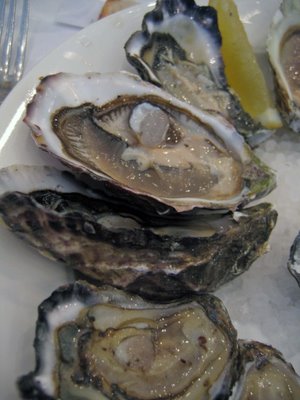 Sydney Rock – Pambula, NSW
Sydney Rock – Pambula, NSWVery salty; short aftertaste; mild white cheese mould linger.
Pacific – Pittwater, TAS
Very pointy shell, lower salt content; milder flavour; slightly watery; chlorinated edge.
Pacific – Smokey Bay, SA
Large body; less moist in appearance; good balance of salt; very sweet, creamy texture; short finish.
Sydney Rock – Wallis Lake, NSW
Motley flesh; heavy shell; buttery, cream flavour; low salt content; long flavour on the palate; medium length aftertaste.
My overall opinion after tasting all these varieties was that I much prefer Sydney Rock oysters over Pacific and Angasi. In fact I was quite indifferent to the angasi and thought it tasted quite muddy, the way some freshwater fish taste.
I particularly liked the Albany and Clyde River Sydney Rock oysters and enjoyed the Smokey Bay Pacific.
 The oysters were matched with some of the yummiest wines I’ve tried recently. They were all very light bodied with high acidity and slight citrus tones.
The oysters were matched with some of the yummiest wines I’ve tried recently. They were all very light bodied with high acidity and slight citrus tones.2003 Salomon-Undhof Grüner Veltliner (Krems, Austria)
Minerals; herbs; green, youthfulness; significant pepper, lime.
2005 Kanta Riesling by Egon Müller (Adelaide Hills, SA, Australia)
Green apple; honeydew melon; bitter lime; dry finish.
2005 Kellerei Kaltern Pinot Bianco/Weissburgunder (Alto Adige, Italy)
Very light body; floral and honey; red apple; creamy palate; mild flavour overall.
2006 Hunters Sauvignon Blanc (Marlborough, New Zealand)
Heavy with passionfruit; elements of grass; flint and capsicum undertones on the palate; bold aroma and taste.
2006 Norfolk Rise Pinot Grigio (Mount Benson, SA, Australia)
Extended skin contact produced the pink hues; light pear attributes; strong finish.
I was particularly impressed with the Sauvingon Blanc and Riesling, although the 03 vintage of the Grüner Veltliner was also right up there (better than the 04 from the same vineyard).
After the masterful oyster plate we were served a three course meal with yet more matching wines.
 The entrée consisted of still more oysters, this time Pacific oysters were coated in coarse breadcrumbs and fried. They retained their moisture and plumpness but were contrasted with the extreme crispiness of the crumbs. They were served with delicate shreds of smoked salmon and baby rocket leaves.
The entrée consisted of still more oysters, this time Pacific oysters were coated in coarse breadcrumbs and fried. They retained their moisture and plumpness but were contrasted with the extreme crispiness of the crumbs. They were served with delicate shreds of smoked salmon and baby rocket leaves.This was matched with a delicious 2005 Plantagenet Hazard Hill Semillon Sauvignon Blanc (Margaret River, WA, Australia). It had tropical scents and bold, crisp apple flavours with a hint of lemon. I really enjoyed this wine even though I’m not a big fan of Semillon (this was 80% Semillon, 20% Sauvignon Blanc).
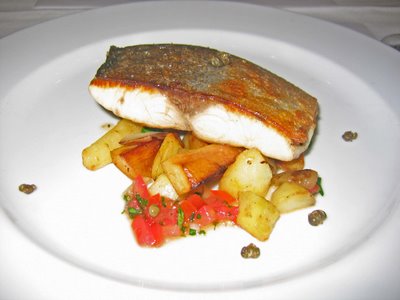 For our main course we indulged in farmed Hiramasa kingfish with roasted kipfler potato and parsnip and a tomato, parsley and caper salsa. The fish was cooked perfectly: the flesh flaked under a fork and had a soft bounce in the mouth. The skin had been salted well and its crispy texture contrasted well with the sweet meat. Very well done considering the kitchen was pumping out 80+ to feed all the guests at the Oyster Forum.
For our main course we indulged in farmed Hiramasa kingfish with roasted kipfler potato and parsnip and a tomato, parsley and caper salsa. The fish was cooked perfectly: the flesh flaked under a fork and had a soft bounce in the mouth. The skin had been salted well and its crispy texture contrasted well with the sweet meat. Very well done considering the kitchen was pumping out 80+ to feed all the guests at the Oyster Forum.With the kingfish we were served a 2004 Sticks Pinot Noir (Yarra Valley, VIC, Australia). This had strong cherry aromas and light red fruits on the palate. It was a very easy to drink, a light summer red.
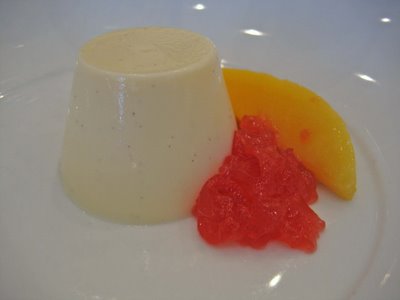 For dessert we were served pannacotta. I am usually very disdainful of pannacotta. It’s ubiquitous on Australian restaurant menus and it’s rarely done well. More often than not you battle between gluggy mush or hard gelatine rocks. The flavouring of a pannacotta is also a delicate balance, with many tasting very bland.
For dessert we were served pannacotta. I am usually very disdainful of pannacotta. It’s ubiquitous on Australian restaurant menus and it’s rarely done well. More often than not you battle between gluggy mush or hard gelatine rocks. The flavouring of a pannacotta is also a delicate balance, with many tasting very bland.Manta’s buttermilk pannacotta was delicious. It had the perfect texture, soft with a slight resistance. In the mouth it was clean and creamy, without any residue fats. The flavour was a gorgeous sour-sweet, coming from the buttermilk and black flecks of vanilla bean. It was served with a prosecco and blood orange jelly (repetitive flavour of the aperitif) as well as a slice of firm mango. I was really happy with this ending.
The pannacotta was served with a 2005 Brown Brother’s Moscato. As sponsors of Good Food Month their wines are served at all incorporated activities, but a good Italian Moscato d’Asti puts this replication to shame.
I’m just spoilt. Sigh.
Even though a drizzling rain arrived, this was a wonderful Sunday afternoon. I learnt so much about oysters, I discovered Manta is an excellent restaurant that I'd love to visit again and I stumbled on some beautiful wines for the summer.
I can't believe I got a lesson in Oysters 101, a welcome cocktail, 5 tasting wines, 13 oysters, a three course meal with matching wines and all for $85!
Good Food Month indeed!
Be sure to visit Cucina Rebecca's round-up of all the other Good Food Month events other Sydney food bloggers are involved in.
Tags: morsels and musings food blog food and drink australia sydney good food month gfm restaurant reviews restaurants reviews oysters oyster manta pacific oyster sydney rock oyster angasi oyster angasi seafood kingfish hiramasa kingfish hiramasa pannacotta wine white wine manta oyster forum



I was there today! I thought it was such great value and also will go back and check this restaurant out.
ReplyDeleteI agree re. the Angasi - it was awful.....or an acquired taste to say the least. My favourite was the Wallis Lake oyster.
cheers - Belinda.
Wow - what a great detailed description! And you're right, it looked excellent value. I like the idea of using the bath to grow oysters!
ReplyDeleteyou are insane anna.
ReplyDeleteocd.